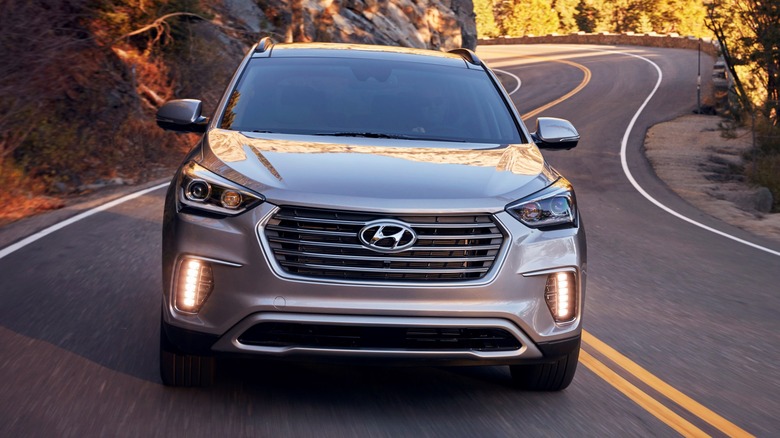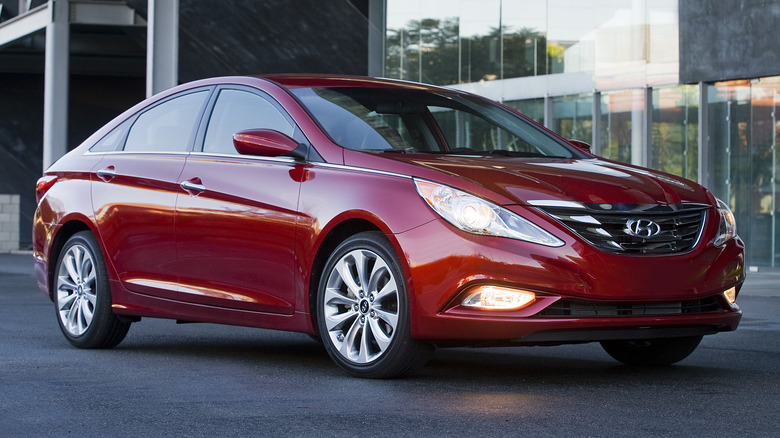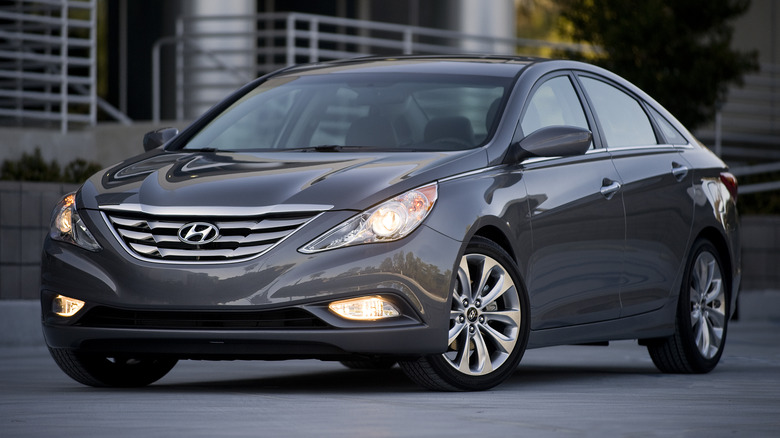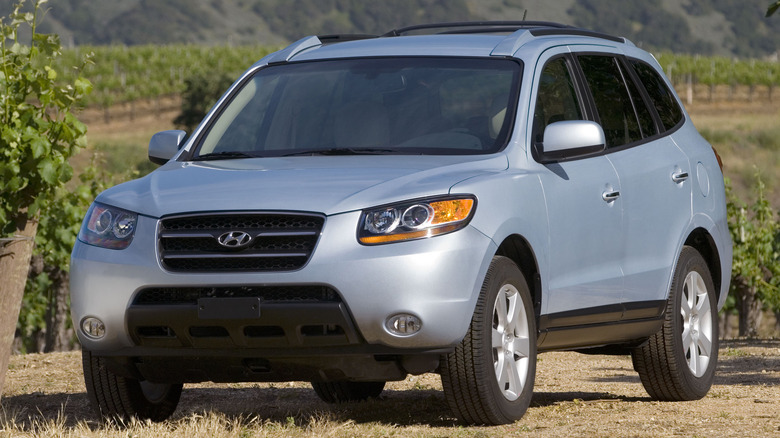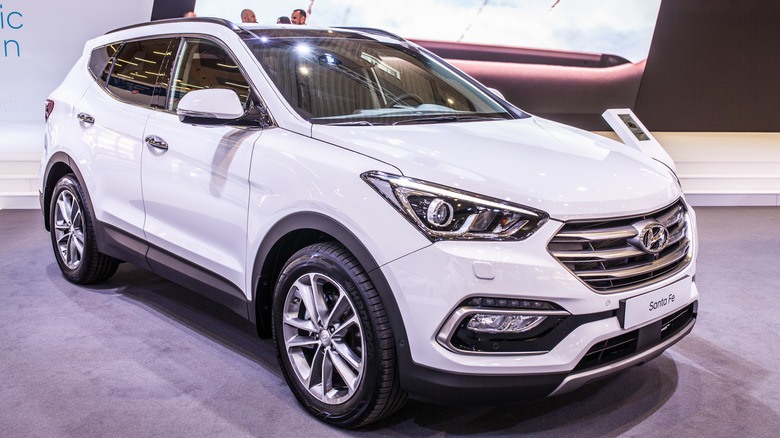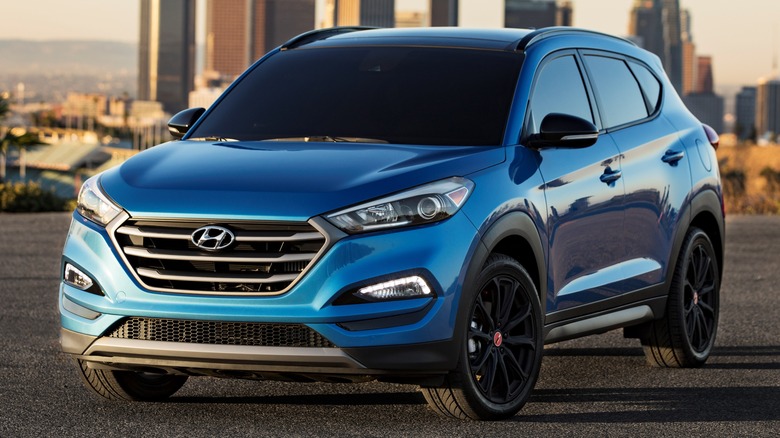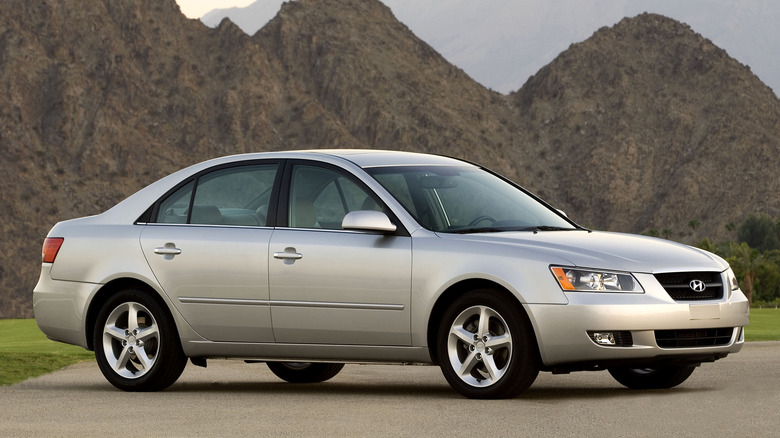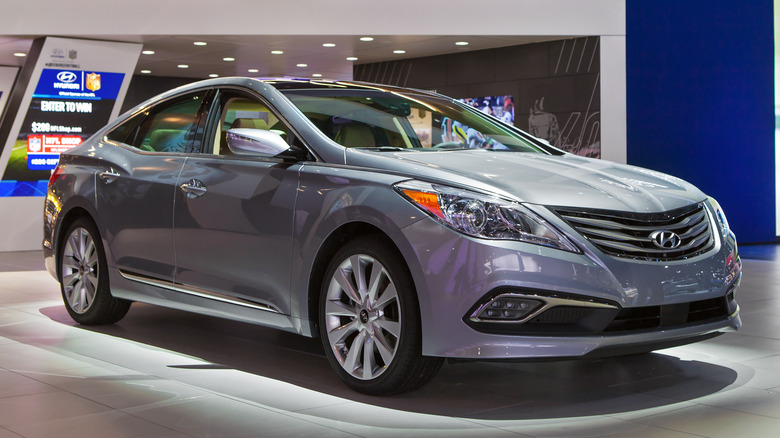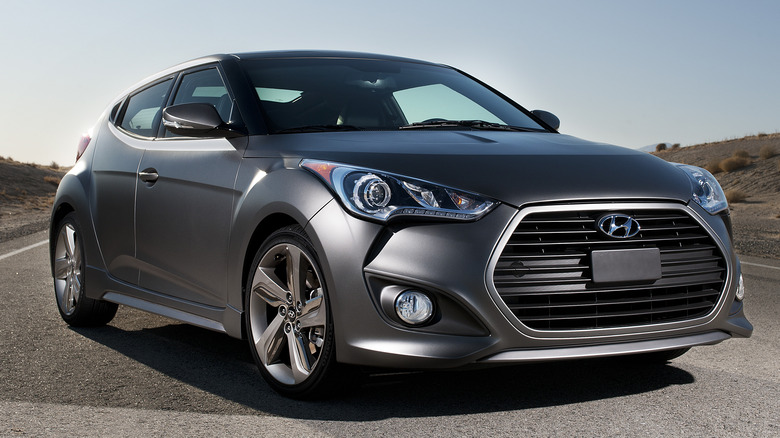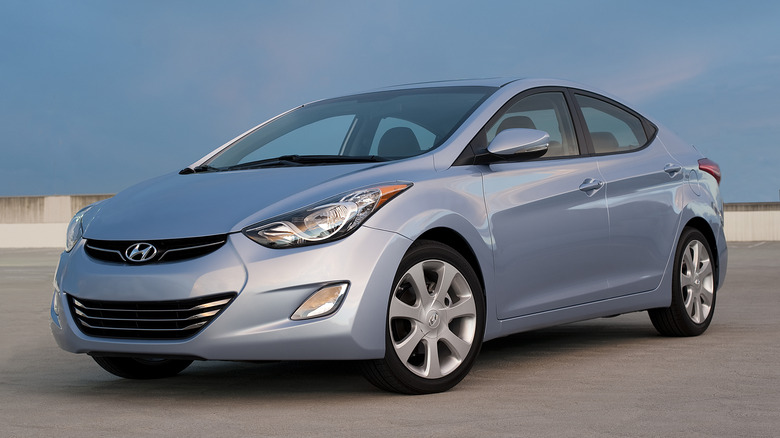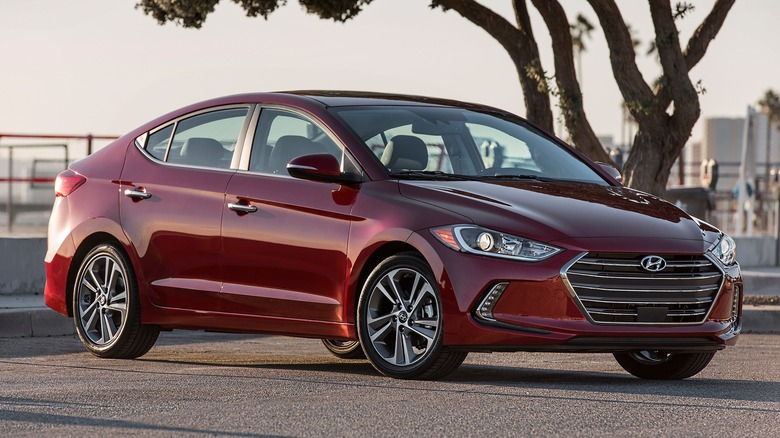10 Used Hyundai Models You Should Steer Clear Of At All Costs
Hyundai, like many of its other regional rivals, has a decent reputation for making solid, reliable cars. The numbers back that up, too, with the manufacturer doing reasonably well in the J.D. Power Vehicle Dependability Surveys. The Korean manufacturer has tended to be one of the top performers of the 2020s, with its cars usually boasting below-average problem rates — 2024 being one of the few exceptions — and competing favorably with names like Toyota and Nissan in the 2022 and 2023 surveys.
So you're pretty safe if you're buying a Hyundai made in the past few years – exploding seatbelt issue aside. What if you're considering older Hyundai models from the 2000s and 2010s? Well, that's where you want to be a lot more careful. While there are undoubtedly a bunch of great Hyundai models from those years, there are also quite a few that have been nightmares for their owners — at least, judging by complaints on the NHTSA's website.
A few of these have the unenviable accolade of having more than 1,000 complaints, with one model in particular managing more than 3,000 owner complaints since it launched in 2011. So, before you commit to a used Hyundai, read on to find out all about the used Hyundai models you really should avoid.
2011 Hyundai Sonata
If there were ever a car we could describe as a red flag on four wheels, the 2011 Hyundai Sonata would be it. It got off to a reasonable start, winning the Rocky Mountain Car of the Year award in its debut year, but things quickly started going south for the car and its owners.
In the years since its launch, the 2011 Hyundai Sonata has amassed an amazing 3,200 complaints on the NHTSA website alongside 14 recalls, mainly for severe issues such as an ABS-related fire hazard, leaky brake lines, and fracture-prone front coil springs. The complaints don't paint a pretty picture, either, with nearly 1,000 complaints alone about the Sonata's engine. Owners report all manner of issues with the Sonata's gas engines, including random loss of power, an error code triggering limp mode, excessive oil consumption, and, most damning of all, total engine failure due to metal shavings leftover from the manufacturing process.
The only part of the 2011 Sonata in worse shape than the engine is the steering. The most common issue is with the electronic power steering, which develops an intermittent problem that causes steering difficulties. There was a recall for this issue, but owners whose VINs were not involved have also reported steering woes. Many of these issues have happened repeatedly for some owners, leading to buyers needing to find replacement engines and components, among other costly repairs.
2012 - 2013 Hyundai Sonata
2011 was a terrible year for the Sonata, but the next couple of years weren't all that great either, making the sixth generation of the Sonata one of the worst ever for the nameplate (and for Hyundai). Both model years have around 1,500 complaints on the NHTSA website, with the government agency recording 1,449 complaints for the 2012 Sonata and 1,724 complaints for the 2013 model.
Broadly speaking, both model years suffer from similar issues as their 2011 predecessor, with engine woes leading the way for user complaints. The same metal shavings present in the 2011 Sonata engine were still present in 2012 and 2013 Sonatas, leading to premature and catastrophic engine failure for some owners. Other Sonata owners have had issues with excessive oil consumption, often accompanied by an oil warning light that won't come on. One major red flag is that many Sonata drivers have had trouble getting Hyundai dealers to honor their warranties for defects such as these.
If the engine woes weren't enough of an issue, the steering system on the 2012 and 2013 Sonatas is also problematic, albeit for somewhat different reasons. The common issue is with the steering coupler, which can go bad and cause knocking and excessive play in the steering. To its credit, Hyundai extended the warranty on the part, but that's not much comfort if the replacement couplers fail soon after installation — which happened to more than one 2013 Sonata owner.
2007 Hyundai Santa Fe
Hyundai launched the second-generation Santa Fe for the 2007 model year in the U.S., boasting an all-new unibody platform and new engines at a lower price than its first-generation forebear. While this better value may have been a plus point at launch, the Hyundai Santa Fe's value-first design may have come at a cost in the long term.
There have been nearly 700 complaints on the NHTSA website since the 2007 Santa Fe debuted, although they're not as ruinous as those on some of its stablemates. The 2007 Santa Fe also has a handful of airbag-related issues, all of which could be potential safety hazards. For example, there's a known clock spring issue that can cause the driver's side airbag to not deploy in a crash. Hyundai recalled the car to fix this in 2011, but the presence of recent complaints shows that there are likely many owners who didn't send their cars in or who weren't told that their cars weren't part of the recall — only for the problem to rear its ugly head anyway.
The 2007 Santa Fe also has issues with the brake light switch, which can get stuck and prevent the brake lights from coming on under braking. The fuel sender is also problematic and tends to fail, with official replacement parts being equally prone to failure according to owner complaints.
2017 Hyundai Santa Fe
Hyundai's third-generation Santa Fe had been around for three years before the company gave it a facelift for the 2017 model year, complete with other improvements such as extra infotainment and enhanced safety technologies. Unfortunately, despite retaining most of the underpinnings and powertrain, the 2017 Santa Fe was a step back in the reliability stakes, with more than 700 complaints to date recorded on the NHTSA website.
The 2017 Santa Fe's main issue involves the engine, which tends to stall randomly while driving. Hyundai issued a recall in 2017 for this fault, citing engine bearing wear as the primary culprit. However, more than a few owners whose cars were not part of the recall claim to have faced similar engine issues, and the significant number of engine failures reported in the past few years — including from second-hand owners — seems to point to a widespread problem that's not limited to just a select number of recalled vehicles.
Owners also report transmission issues such as rough shifting and missing gears along with troublesome steering, with the latter tending to "stick" in a particular direction when driving above certain speeds (usually around 40 to 50 mph). There's also an active (as of 2024) recall for the 2017 Santa Fe due to a fire hazard from the ABS unit. While this should, in theory, be a non-issue once a car's been sent in for repair, it is something to watch out for when shopping around.
2016 - 2017 Hyundai Tuscon
Hyundai refreshed the Tucson for the 2016 model year, with the third generation introducing a new exterior, larger body, and all-new four-cylinder turbocharged engine mated to a new seven-speed automatic. Unfortunately, the new powertrain seems to have been a big misstep, at least judging by complaints on the NHTSA website for both years. The 2016 Tucson has over 1,400 complaints, with the vast majority (over 800) involving the drivetrain.
All the usual suspects are present — random and sudden loss of drive, hesitant gearshifts, excessive oil consumption, and totally wrecked engines. Some owners have only had engine issues, some only transmission issues, but more than a few have had troubles with both components of the drivetrain. Quite a few contemporary Hyundais — like the 2016 Veloster — were recalled for similar symptoms attributed to premature rod bearing wear, but not the 2016 Tucson. The 2017 Tucson has similar issues, with more than 80% of its 800-plus complaints on NHTSA highlighting similar issues as its predecessor.
Both Tucsons also have issues with their doors. More specifically, some of the doors will eventually fail to open. Some owners have had the rear doors stop opening, while others have had trouble with the front. Either way, it seems that some of the door latches will eventually fail, posing a potential safety hazard in an emergency. Like many contemporary Hyundai cars, the 2016 and 2017 Tuscons have an active recall for a fire hazard caused by the ABS unit.
2006 - 2007 Hyundai Sonata
The Sonata was at its worst in the early 2010s, but the first few years of its fifth-generation iteration weren't too hot, either. The 2006 Sonata was an all-new take on the nameplate, with improvements over the previous generation earning it accolades from outlets such as MotorTrend, who praised the 2006 Sonata for its great value.
However, while the press enjoyed the car, owners soon began having issues with the 2006 Sonata and its follow-up a year later. The most common issue on both fifth-gen Sonatas is with the passenger seat airbag sensors, which often fail to detect smaller occupants, mistaking them for a child. Hyundai was quick to issue a recall in 2008, but many owners since have noted that the issue tends to recur even with all-new components.
Another related issue is that the airbag warning light comes and stays on because of a faulty seat belt buckle pretensioner. Hyundai extended the warranty coverage for this part to 15 years (or 250,000 miles), but reports of the issue occurring after the cutoff period to indicate that it's either a recurring fault or one that many owners neglected to send the car in for.
2016 Hyundai Sonata
Hyundai definitely improved the Sonata after its early-2010s nadir, but the 2016 Sonata was a reminder that Hyundai (and the nameplate) wasn't necessarily out of the woods yet. The 2016 Hyundai Sonata has just over 600 complaints on the NHTSA website, with many owners citing problems with — you guessed it — the engine.
The 2016 Sonata's internal combustion engines seem to have major issues with excessive oil consumption. Owners report pouring in a quart every 750 miles or so, with many owners alleging that Hyundai dealerships have mostly been unwilling to address the problem or acknowledge that there's even an issue. This makes the 2016 Sonata a bit of a pain to keep running, especially when the check oil light doesn't always turn on. Of course, the bigger issue is that it exposes you to the risk of engine damage from previous owners running the engine without enough oil — or, even worse, completely dry.
It's probably no surprise that an engine with oil consumption issues also has a track record of failing, and that's exactly what's happened to more than a few 2016 Sonata owners.
2013 Hyundai Veloster
Hyundai's unique turbocharged "coupe" turned heads when it launched for the 2012 model year boasting an asymmetrical three-door design. The model ranks as one of the most reliable Hyundai models ever, with the worst of the bunch — the 2013 model we're discussing here — still only having fewer than 400 complaints on the NHTSA website.
So it's not necessarily the trainwreck that some of its stablemates have been over the years, but the 2013 model is still one to avoid if you're interested in a sporty Hyundai on the used market. The 2013 Veloster's issues mainly involve the engine, which tends to consume too much oil. As with many such issues, many owners again claiming that the check oil light often fails to come on — exposing the engine to severe damage if run for an extended period with little or no oil.
As of 2024, there's also an active recall for a fire hazard posed by the Veloster's ABS unit. While we hope that this shouldn't be a problem in the long term, it is something to watch out for if you're buying a used car. That said, given all the other cases we've seen of non-recalled cars developing the same issues as their recalled brethren, we think it might be a good idea to steer clear here to be on the safe side.
2012 - 2013 Hyundai Elantra
The 2012 and 2013 Hyundai Elantras came in three variants — hatchback, coupe, and sedan — but all have proven over the years to be troublesome cars to own. The 2012 Elantras have around 600 complaints on the NHTSA website, while all three versions of its successor have an unenviable 1,200 complaints on the NHTSA website.
As with many other Hyundais on our list, the main problem with the 2012 and 2013 Elantras is the engine. More specifically, the engine tends to develop what owners describe as a "slapping" sound resulting from a problematic piston or cylinder, with the final result being the need for an entirely new engine. Hyundai extended its warranty to cover this problem, but that's of little comfort if you're buying a used 2012 or 2013 Elantra today. The fact that this wasn't a full recall also means that there's no guarantee the car you're buying is safe from developing the problem down the line, making these two Elantra years something of a ticking time bomb.
All three models also suffer from premature wear to the steering coupler. This starts out as a benign clunking or squeaking but, according to some complaints, can lead to total loss of control if not fixed — usually by installing a replacement steering column. Like many of its contemporaries, the 2012 and 2013 Elantras also have an active recall going as of mid-2024 for an ABS unit-related fire hazard.
2017 Hyundai Elantra
Hyundai's Elantra never quite hit the same lows it did in 2013, but that doesn't mean that the following years were ever truly trouble-free. Case in point — the 2017 Hyundai Elantra (and Elantra GT), which, while having only 600 complaints on the NHTSA website, is still troublesome enough that you are likely better off avoiding it.
Like its troublesome early-2010s predecessor, the 2017 Elantra's engine has a major issue with the engine. Many of the 200-plus engine-related complaints have to do with the car randomly stalling or losing power when driving, with some owners pointing out the presence of the dreaded engine knock that was so prevalent on the 2012 and 2013 Elantras. Unfortunately, like the earlier models, the only solution for this issue is a whole new engine. Given that Hyundai didn't issue a recall for this problem, there's a chance that the engine in your used 2017 Elantra will eventually fail.
Another common complaint owners have had about the 2017 Elantra is that the doors tend to stop opening eventually. It seems random which doors fail, as some owners have had their right rear door fail first, while others have the driver's door start causing issues before the others. This is both tedious and a serious safety hazard, potentially trapping occupants inside in an emergency.
Our selection methodology
The NHTSA website tracks owner complaints and recalls for cars sold in the U.S. and was our primary source when building this list. We focused on the number of owner complaints for a vehicle, with the nature of those complaints also playing a big part in our decision-making. For example, we deemed costly issues with components such as the engine or powertrain more serious than relatively minor issues such as poor paintwork or finicky sunroofs.
Manufacturer recalls also influenced our selection, as they're another useful indicator of problematic cars. Ideally, the previous owner(s) of the vehicle should have sent it in if it was part of a recall, but we've seen and read enough complaints about recurring issues and non-recalled cars exhibiting issues to feel that there aren't any guarantees here. Recalls alone don't make a model one to avoid, but they certainly don't help.
A final warning — this list isn't exhaustive, and Hyundai had a bad few years in the late 2000s and early-to-mid 2010s. As such, we strongly recommend checking the NHTSA website and doing a ton of research before buying, even if the model year you're considering isn't on this list.
